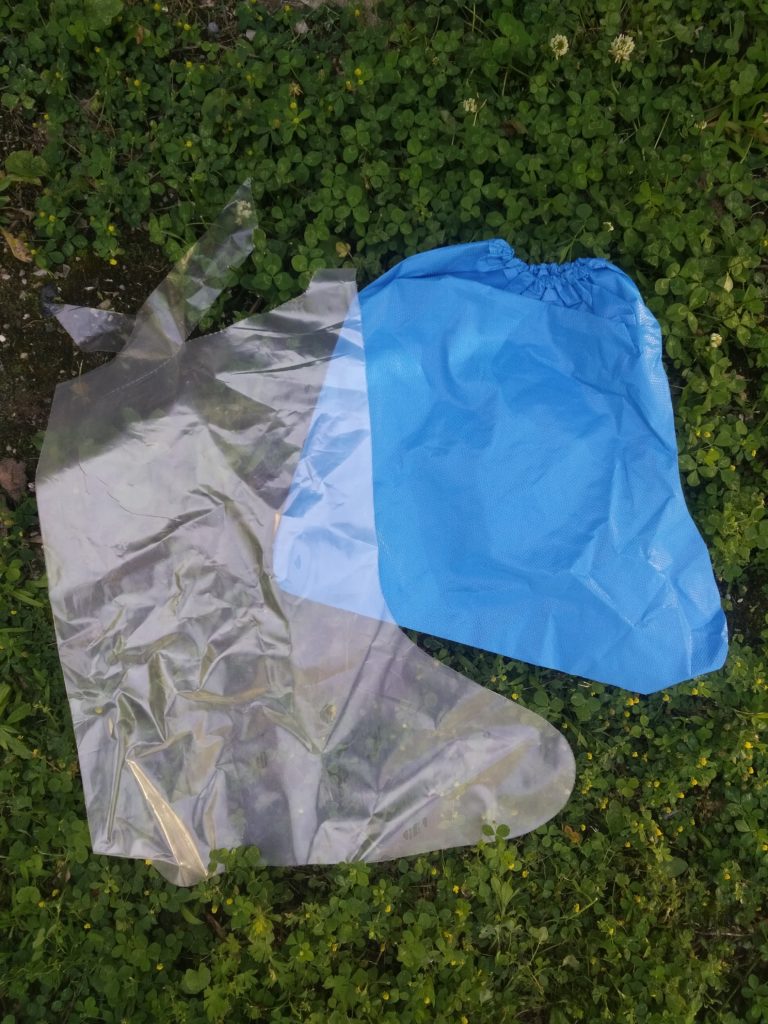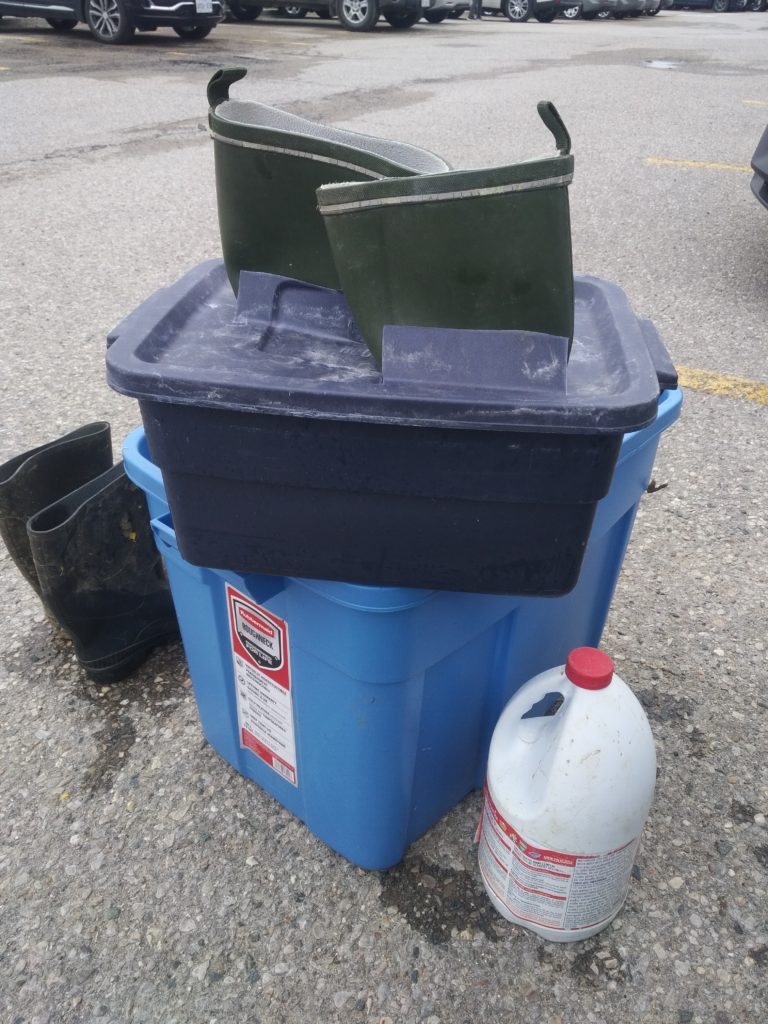Scouts and agronomists may put biosecurity measures in place with a certain disease or crop in mind, but should ensure protocols are in place each and every time you walk fields. Crops are grown in rotation, so the soil in corn fields may contain soybean cyst nematode and soil in wheat fields may contain clubroot disease that infects canola.
What are the highest risk pathogens?
In order to carry out appropriate biosecurity measures, you should know what pathogens are the highest risk and use a disinfection product that kills those pathogens. It is actually somewhat difficult to find information on what products effectively kill each plant pathogen as there is often more focus on efficacy against animal pathogens. Required rates of the products may vary too.
Virkon is commonly used to kill fungal and bacterial pathogens, and instructions for its use come with the product. However, clubroot for example, is not a fungus or bacteria and the best disinfection product is a 2% bleach (sodium hypochlorite) solution. Anthracnose of dry beans may require a 5-10% bleach solution to be killed. Aquacare (chlorine dioxide) and Dettol (chloroxylenol) are other products that can be used to control a number of pathogens.
Where are the high risk pathogens – on plants or in soil?
You should also consider where the high risk pathogens are located. Pathogens in the soil can be managed with boot covers or boot washing, but many pathogens are on the stems and leaves of the plants themselves. Anthracnose on dry bean leaves can easily be collected on pant legs and transferred across a field or to other fields.
If plants are taller than your boots, you could wear gaitors (Figure 1). You would need to switch out soiled gators between fields, and machine wash them at the end of the day. For even taller plants, be aware that you could be carrying pathogens on your shirt. Weed seeds and insects can collect on clothing or in your boots, so dump out your boots and brush off your clothing upon exiting a field.

Some General Tips:

- Do not park your vehicle in the field, keep it on the road or gravel field entrance.
- Use separate boots for driving and for walking fields to keep your vehicle free from soil.
- Rubber boots are the easiest to clean and you may not want to use bleach or disinfectants that discolour or deteriorate more expensive work boots. Carry extra pairs of clean rubber boots to save time.
- Boot covers (Figure 2) are good for quick visits to the field but can rip easily and create a lot of waste. Stronger clear plastic boot covers are available (e.g. at TSC). Place used boot covers in a sealed garbage bag to keep your vehicle clean.
Regarding Bleach:
- Bleach is likely the cheapest disinfectant solution, as well as the easiest to find and is active at the lowest concentrations.
- Ensure the product you purchase is sodium hypochlorite and note the concentration of the bleach on the bottle you purchase.
- Bleach can discolour or deteriorate your work boots. One summer of repeated bleach washing will likely ruin the look and integrity of leather boots (e.g. leather boots become stiff).
- Bleach and other products may be inactivated by organic matter so simply spraying soil-covered boots with a bleach solution is inadequate, you must first remove as much soil as you can.
- Organisms must be exposed to disinfectants for several minutes to be killed.
- Bleach is the preferred product for killing clubroot spores; a 2% bleach solution is required. Clubroot must be exposed to bleach for 15-20 minutes.
The Boot Wash Approach:

- After exiting the field, knock as much soil off the boots as you can by banging and scraping; use a stick, knife or hoof pick. Dump weed seeds and soil out from inside the boots and brush your clothes off.
- Use clean water to wash off all remaining soil, or as much as you can. You can use a pressure washer (e.g. hand pump style, Figure 3) filled with clean water, or a scrub brush, or both. Removing all soil, or as much as you can, before using a disinfectant is important because soil may deactivate the disinfectant product.
- Put the boots in a tub with disinfectant solution. The boots should be covered with the solution, with just the tops sticking out. Scrub the tops of the boots with the solution too. Leave boots in solution for 20 minutes, maybe while you drive to the next field.
- It is advisable to use a small or medium sized Rubbermaid style tub for your bleach solution, then put the small tub inside something larger so it does not spill in your vehicle (Figures 4 and 5). Some sloshing action while driving can be helpful for the cleaning process! You can cut holes in the lid of the small tub for your boot tops to stick out of, and can even clip the top of your boots to the lid so they do not tip over and fill with water
- If disinfectant solution has a lot of soil in it, it should be replaced. You should make a new solution each day.
- Be sure you have a safe place to carry these task out; be cautious at the side of the road.


Cleaning Tools and ATVs
A similar approach to the above boot wash details can be used for cleaning tools used in the field, such as soil probes and buckets. A similar approach can also be used with ATV tires. Scouts using an ATV will have to find a plan that works for them. It may work well to knock and scrape loose soil off tires, pressure wash with clean water, then spray down with a 2% bleach solution.
Biosecurity for Commercial Farm Equipment
Biosecurity protocols for farmers and custom field applicators can be very difficult to implement. The best way to prevent the spread of pathogens or weeds would be to completely clean and disinfect equipment between every field or every farm operation. This is almost impossible to carry out during the busy growing season but we should start to consider what we CAN do.
Clubroot is a significant threat to canola production in Ontario, and it can live in the soil for years and years. Sanitation practices should be carried to reduce transfer of this disease regardless of the crop being grown in a given year or field. It can be highly beneficial to take 15 minutes to clean loose soil off equipment and tires when leaving each field. The spread of clubroot is a numbers game; the less soil you move from one field to the next, the less likely you are to move the spores. Keep a stiff broom in the sprayer or tractor to knock the majority of loose soil off of equipment before heading to the next field. Efforts should be made to periodically clean ALL soil off equipment back at the shop when time allows, particularly for custom operators who visit many farms in canola growing regions. These practices would also reduce spread of other soil borne pathogens like soybean cyst nematode.
Clubroot disinfection info: https://www.canolawatch.org/2018/06/27/clubroot-disinfectants-bleach-is-best/
Thanks to Dan Orchard at the Canola Council of Canada for tips on making a boot wash station.